Tomas Nyqvist (No Fashion Records / Putrefaction Magazine)
2016-09-08
by Niklas Göransson
The architect behind two structural foundations of the Swedish metal underground shares his story – one burdened by death and deceit, serving as a reminder of the fickle nature of life and how everything can be swept away by the stroke of a hand.
A printed version of this article is available in Bardo Methodology #1, which also features BÖLZER, SADISTIK EXEKUTION, PHURPA, ANTAEUS, Ryan Förster (BLASPHEMY) MORBID, Alvaro Lillo (WATAIN), TEITANBLOOD, FORNDOM, MGŁA, The Ajna Offensive, and DESTRÖYER 666.
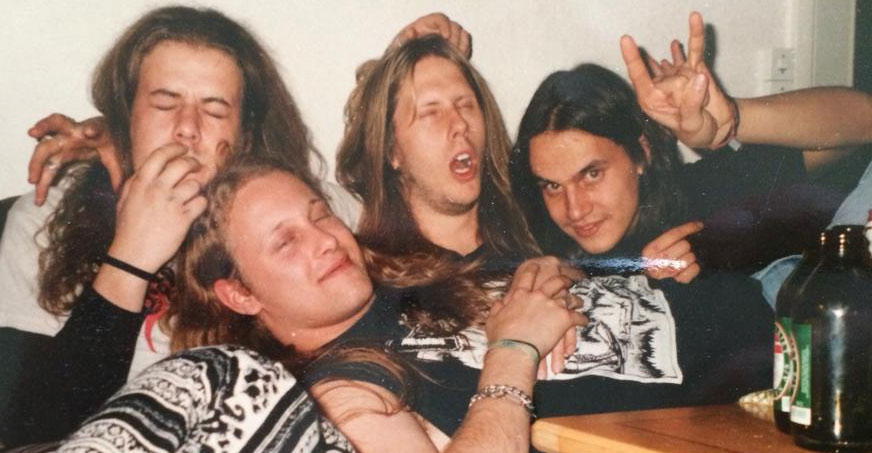
– The seeds were sown in 1988, says Tomas Nyqvist, I was 14 years old and lived in a small town with nothing to do. I’m useless as a musician but really wanted to do something and take an active part in the underground.
Like most of his peers, he’d stay up to date by reading the contemporary publications that would prove essential for the emerging scene.
– Especially Morbid Mag and Slayer Mag. They were my inspiration to start one of my own.
Fuelled by a rabid, obsessive hunger for everything related to obscure metal, Tomas founded Putrefaction Magazine.
– I was one of these kids that didn’t really attend school all that much. When they found out I was doing a ‘zine, I was put in one of these adjusted study programmes where I could work on it during school hours. They also offered to cover the printing expenses.
Considering the time – with W.A.S.P. being proclaimed a national emergency on state television, it’s quite ironic that Swedish tax payer money would be funding the growth of a now world-renowned death metal underground. The fledgling entrepreneur’s first course of action was to send questions to some of his favourite Swedish bands – a few of those that responded were CARNAGE, ABHOTH, and EMBALMED.
– Once the material was ready, I arranged and cut-and-pasted everything together, then drew the logos with a black sharpie. I thought it was really cool.
The first issue was printed in 100 copies and released in the autumn of 1989.
– ‘How the hell am I to get rid of 100 ‘zines?’ I thought.
Despite his tender age, Tomas was a devout tape trader and corresponded with people from all over the world. After printing flyers heralding the birth of Putrefaction, he began including them in his cassette trafficking. And so word spread through the underground.
– I’ll never forget the moment my first order came in, two copies for someone in the Netherlands. I was just amazed that some Dutch guys wanted to read my magazine; it was an incredible feeling – 14 years old and I’d just earned 40 crowns.
Note that in 1989, 40 Swedish crowns had the same buying power as 68 crowns do today. That’s 8 US dollars, or 7 Euros. The second issue came pretty soon after the first one – February 1990.
– Sitting at home, hammering away at my type-writer – this was obviously long before the age of computers. I started sending questions to American and European bands and even managed to get an AUTOPSY interview, I was ecstatic despite it being little beyond ‘yes’ and ‘no’ answers.
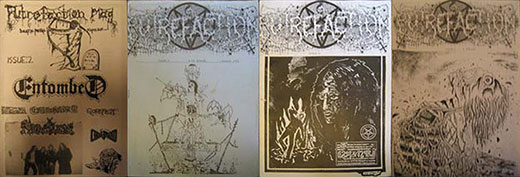
The big break came later that year with the third issue, which featured MAYHEM and MORBID frontman Pelle ‘Dead’ Ohlin on the cover.
– The interview turned out pretty good, Tomas comments, considering my limited English skills – he also sent me a bunch of photos and drawings that I ended up using. I must have sold 500 copies of that issue, mostly because of him. This was in 1990 – one year before … well, he’d just moved to Norway, I think.
Conveniently, the conversation is graced by the presence of interactive fact-checking in the form of MORBID bass player; Dr. Schitz.
– No, he interjects, Pelle left for Norway in the beginning of 1988.
– Right, says Tomas, he’d gained a huge following in the underground by then. Nowhere near where it is now obviously, with Hollywood movies and everything.
The interview features some scathing commentary about the state of death metal, citing the use of Bermuda shorts as an example.
– Life metal, Dr. Schitz observes, in Pelle’s perspective.
– Exactly, Tomas continues, he was incredibly anti-everything that was commercial. He wanted to be as underground as he could possibly be.
Dr. Schitz says that his friend became all the more ambivalent as to what he wanted to achieve, at least in this life.
– I remember discussing a MORBID single we’d planned; one moment he wanted to print 20 copies and only have it sold in some underground store in Greece, next thing you knew he was talking about 2000 copies. Towards the end, he kept going increasingly back and forth.
While there was a steady stream of grand declarations from the already notorious MAYHEM, there was very little actually happening in regards to output.
– Simultaneously, he adds, many of the Swedish bands that Pelle had pissed on in interviews were drinking beer in nightliners – being driven to shows across Europe. He had missed that train, and it was really starting to eat away at him.
Over the three years he was part of MAYHEM, they played only four gigs outside Norway – three in Germany and one in Turkey.
– It certainly wasn’t for loss of trying, Tomas says, they attempted to put together several tours. At the same time, everything had to be so completely anti that it ended up falling through. Dead never did manage to get his head straight about it.
In a cruel twist of fate, the fervent adversary of anything mainstream is now part of mandatory metal history.
– It’s so bizarre with that upcoming Hollywood movie, says Dr. Schitz, this Lords of Chaos about Norwegian black metal by Scott Ridley. I’m so emotionally invested in this that I can barely think straight, but I was talking to Pelle’s brother and mentioned to him how much it bothered me.
Ohlin’s sibling made an interesting point; without compromising or selling out by anyone’s standards, the persona of Dead is now getting more recognition than he could have possibility fathomed.
– I hadn’t thought of it that way, this solved the dilemma he was grappling with. It was a genuine quality of his, this uncompromising integrity.
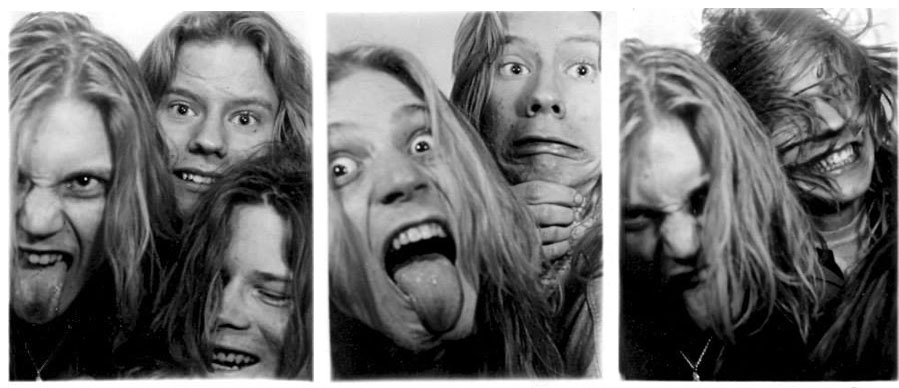
Before leaving friends, MORBID, and family behind in Stockholm at 19 years of age, Ohlin was already renowned for his total dedication to the fundamental concepts of black and death metal. Once he partnered up with Øystein ‘Euronymous’ Aarseth, MAYHEM’s guitar player, his fervour had reached obsessive lengths.
– I met him once, says Tomas, Euronymous that is. One day in the early nineties he showed up at my place together with Faust (EMPEROR).
The duo needed records for their store back in Oslo, Helvete.
– ‘Sure’, I said, ‘what are you after?’ They wanted 50 copies of each No Fashion release; ‘alright’, I said, ‘and what about the money?’ I was told it would be sent to me, which unfortunately never happened.
– Euronymous was even more hopeless as a businessman than you were, Dr. Schitz notes, I can assure you that he had every intention of reimbursing you, and didn’t mean to rip you off.
He recalls a cunning plan the Oslo boys had concocted, of making some quick money by putting out a METALLICA bootleg.
– 1000 copies ordered and but never collected since they couldn’t scrape together the funds to pay for them. I think it’s safe to say that you were financially savvy in comparison.
– Of course, says Tomas, I don’t really care. I loved MAYHEM so it was huge for me to even have them as guests in my home.
Ohlin later sent Tomas a rehearsal tape recorded in the old house he’d moved in together with Euronymous and MAYHEM drummer Hellhammer. This is probably the recording that ended up released as “Out from the Dark” in 1996.
– I worshipped that tape, it was so fucking good. They kept claiming that they were about to record an album, but nothing ever happened.
Something that fortunately did happen was the sole MAYHEM studio recording with Dead on vocals; the songs “Freezing Moon” and “Carnage” from the Projections of a Stained Mind compilation. It was organised and designed by Dr. Schitz, and released by Chicken Brain Records in 1991.
– When I was putting it together, he says, I nagged Pelle endlessly to get them to record – and finally they did.
Tomas points out that we should all be grateful for Dr. Schitz’s pestering resilience, as these audial treasures would have never existed otherwise.
– I remember the first time I heard those songs, says Tomas, and just … wow, fucking hell. I’d listen to them over and over again, and was really looking forward to the album. They had already decided what the title was going to be.
“De Mysteriis Dom Sathanas” was released in May, 1994 – at this point, Pelle Ohlin and Øystein Aarseth were both dead.
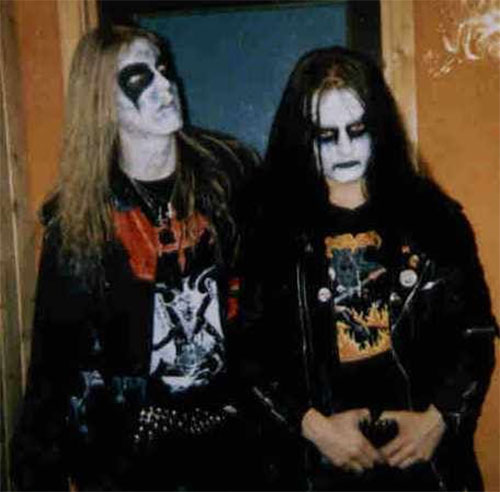
Whereas popular lore attributes Ohlin’s stage name to a previous brush with death as a child, Dr. Schitz has conflicting memories.
– Is there an interview with Pelle where he says that ‘Dead’ came from his near-death experience? I highly doubt that.
The young Ohlin was subjected to brutal bullying in school, and when he was 10 years old he was beaten so badly that his spleen ruptured.
– He went home to try to get some rest and was later found unconscious by his stepmother, who was a nurse. His pulse was weak but I doubt it ever stopped completely; he was rushed to the emergency ward and operated on. I don’t think he was ever pronounced dead though.
Dr. Schitz says he only found out the actual story several years after Pelle had passed away.
– The thing is, he never spoke about it. He even lied to his friends about the scar, claiming it was from eating poisonous mushrooms and having to get surgery, but that was the only thing he ever lied about. In my opinion, he couldn’t bring himself to talk about what had really happened.
Trauma victims will often desperately try to avoid the source of the distress – and in doing so, some will instead end up becoming fixated with it.
– And so, he continues, Pelle became obsessed with death. This obviously contributed to the choice he ultimately made but it’s not why he did it. He was alone in that shitty house, it was Easter and of all his friends were either with girlfriends or family.
MAYHEM was going nowhere, he continues, Pelle had begun starving himself and was displaying self-harm tendencies.
– He stopped taking care of himself and was no longer even washing at this point. I think we can establish without any reasonable doubt that he was deeply depressed.
![image[1]](https://www.bardomethodology.com/wp-content/uploads/2016/09/image1.jpg)
Dr. Schitz says that in most cases of depression-related suicide, it doesn’t happen when the afflicted is at the absolute lowest. It usually follows a brief alleviation of the pain, in the wake of a glimpse of light.
– In this case, it was his decision to move back home to Sweden. Pelle had applied for art school and we had started rehearsing with MORBID again, his mother later told me he was incredibly excited to be back playing with Gehenna (guitars) and me.
Then why didn’t he follow through?
– While there was a chance of real change just around the corner, I don’t think it felt all that appealing to him.
Especially coming back home empty-handed after all this time, when many of his former friends had become successful musicians.
– When we rehearsed, I imagine he must have realised that things were never going to go back to the way they once were – we had grown up, and had jobs. No one that knew Pelle would claim a fascination for death was decisive in his choice, he was simply deeply depressed.
Dr. Schitz stresses that these revelations should in no way detract from Ohlin’s artistic integrity.
– His portrayal was genius, genuine and heartfelt – but much of its driving force was a lot more tragic than what’s been projected by outsiders and ascribed to him by Øystein. From our conversations and correspondence I got the impression that Øystein treated him like shit, he bullied him – something Pelle did not handle well. I think taking those fucking photos says more than words can ever convey in this regard.
Pelle ‘Dead‘ Ohlin ended his own life on April 8, 1991; his body was found by Aarseth, who took the now infamous pictures. Dr. Schitz dismisses the claims by the latter that Ohlin’s demise was in any way influenced by the state of the scene as laughable.
– This notion of the suicide having anything to do with corruption of black metal is incredibly naïve. Pelle was miserable and despite planning new beginnings back in Sweden, he simply couldn’t see a way out of it.
After the success of the fourth issue, Tomas felt there was a real demand for his publication.
– My English was terrible but Putrefaction was somehow a hit. I started focusing on US death metal and the South American scene – 600 copies were printed of the fifth issue and they sold out straight away.
Many of them went to smaller distributors, such as labels who also had their own distro. Once they’d sold all their stock, they’d send Tomas back the money.
– It kept going like that. I found a place that could print the magazine in binding, with a proper spine and everything.
It meant a higher cost-per-sale but that didn’t matter as long as it improved the publication. Besides, it was still good money for a teenage metalhead.
– The sixth and seventh issues sold in 1000 copies each, that’s when No Fashion came into the picture. I had to put the magazine in hibernation while I dealt with the record label.
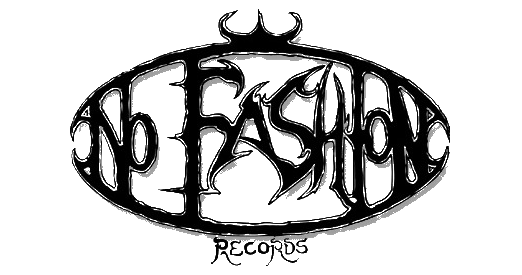
The tragic tale of No Fashion Records began in early 1992, when Tomas came across an obscure Dutch black metal band called BESTIAL SUMMONING.
– It was the most chaotic shit I’d ever heard in my life, I could barely make out a single instrument. I instantly knew that I had to release it.
Tomas had just turned 18 and thus got access to an inheritance from his mother, who had passed away when he was younger.
– Together with the Putrefaction money, this was enough for a starting capital. I printed 1000 LP’s in Norway, at the same place Euronymous used for Deathlike Silence Productions.
Today, “The Dark War has Begun” is a treasured rarity but at the time it wasn’t exactly flying off the shelves. This was also at a time when the CD format was seeing its big breakthrough, rendering its predecessors near-obsolete.
– People were like, ‘what the hell is this?’ I could clearly peddle my publication but this record with its dreadful cover artwork was an entirely different matter. I think it sold 100 copies in the first year, but I never gave up.
![1280x1280[1]](https://www.bardomethodology.com/wp-content/uploads/2016/08/1280x12801.jpg)
Tomas found Norwegian death metal band FESTER and released their album “Winter of Sin” on CD, which sold reasonably well. Then came the MARDUK debut – “Dark Endless”, released in December 1992.
– Morgan (Håkansson, guitar) sent me a demo that I thought was fantastic so I offered to release their record. That’s where things really took off. We printed 1000 CD’s and 500 vinyl; it was a dead format in those days but this was an album that needed an LP version.
One year later, No Fashion Records released DISSECTION’s iconic debut, “The Somberlain”. Like Pelle Ohlin, the band’s frontman Jon Nödtveidt is no longer with us in the flesh.
– Jon was a great guy, says Tomas, really funny. When he lived in Eskilstuna for a period around 1993, we’d catch up almost every weekend. Then … well, something happened within him – he began drifting towards new ideas and kept a different company.
– I know the feeling, says Dr. Schitz.
– We lost contact for a while, but towards the end we were back on track. Anyway, I got to know him in 1989, through his zine Mega Mag.
The two editors were the same age and started talking regularly over the phone.
– He sent me their 1991 “The Grief Prophecy” demo. DISSECTION had a more traditional death metal sound with growling vocals in those days, but filled with these fantastic melodies – the potential was there for all to see.
Tomas says he has no idea if it had any impact, but he actually mentioned to Jon that he should try out different vocals than the deep growls.
– The year after, he sent me a rehearsal tape with a few new songs. It floored me completely, it was so fucking good – I rang him immediately and expressed interest in releasing an album, which he accepted.
![dissection-The_Somberlain[1]](https://www.bardomethodology.com/wp-content/uploads/2016/08/dissection-The_Somberlain1.jpg)
“The Somberlain” was recorded in Unisound Studios during five days in March 1993, under the guidance of its proprietor Dan Swanö.
– It cost me 6 000 crowns (700 USD/625 EUR). I remember talking to Jon before the album came out, and we agreed how amazing if would be if it ended up selling 1000 copies. Underground! We felt confident it would, sooner or later …
They decided to start with 500 CD copies, then monitor the sales and see how long it would take for them to sell. As it turned out, not very long; the lot was gone in less than a week.
– That’s when things really started to go wrong.
In December 1993, Tomas Nyqvist would make the biggest mistake of his life.
– One week after “The Somberlain” came out, he says with a slight edge to his tone, House of Kicks contacted me and said they needed at least 1000 more copies.
House of Kicks was a distribution company and record store where many Stockholm metalheads bought their music in those days.
– I asked them to pay me for the sales, as all of my money was invested in that record. ’Tomas’, they said, ‘it’ll be three months before you get the settlement’. I thought they were joking, how the hell was I to print more? A while later they called me again.
‘Tomas’, they said, ‘we have a great business opportunity for you, can you come to our office?’’
– I travelled to Stockholm and met with them over lunch. The owner said: How about this; you and the bands will each get five percent of the selling price and we’ll handle all printing and distribution?
That would leave both parties with approximately 12 crowns (1, 4 USD/1, 25 EUR) per sold album to share.
– I thought it was a pretty good deal for everyone involved. ‘Let’s do it’, I said – and so we went back to their office where I signed over my label to them.
Did you get a copy of the contract?
– Didn’t even think of asking for one. If I’d done that I might have had a fighting chance – they certainly knew what they were doing, I’ll give ‘em that.
Tomas offers a re-enactment of how he envisions their strategy meeting.
– ‘Here comes this 19 year old kid from the countryside’ he says with a mock voice, ‘who has created something we want. Let’s tell him we’re signing a distribution deal, but instead we’ll just steal everything.’
He claims he never received any payments, and even worse – neither did the bands.
– They’d come to me and ask; ‘Where the fuck is our money?’ I referred them to House of Kicks, who played ignorant and sent them back to me. Repulsive swine of the worst kind.
![393[1]](https://www.bardomethodology.com/wp-content/uploads/2016/08/3931.jpg)
On the subject of bands demanding their money – the same month as the DISSECTION album came out, No Fashion Records presented another milestone release; KATATONIA’s 1993 debut album “Dance of December Souls”. After losing his label, Tomas was convinced things couldn’t get any worse but a lawsuit for 120 000 crowns (14 000 USD/12 530 EUR) moved him to revaluate that position.
– KATATONIA were rightfully pissed, though it shouldn’t have been directed towards me. I didn’t even know what to say; ‘go ahead and sue – I don’t have any money’. Sure enough, it went to court with lawyers and everything, and needless to say – I lost.
Tomas rang House of Kicks and pleaded with them for financial aid.
– ‘You’re making an absolute killing off DISSECTION, you’re pulling in lots of money – I don’t even have electricity in my apartment.’ Their response? ‘Not our problem.’ Life was not good then, let me tell you.
As I was writing up this interview, I thought it’d be interesting to get KATATONIA’s perspective.
– It was immediately clear to us that Tomas had been duped, says guitarist Anders Nyström, but unlike us he’d been given a say in the matter. No one consulted us so we had no insight into whatever deal they struck between them.
Shortly following the takeover, House of Kicks contacted the band to announce that KATATONIA were now under contract with them.
– Under new and entirely different clauses than we signed with Tomas, this really pissed us off. We only wanted out of this mess, to have our involvement nullified since we regarded it as breach of contract.
At the time, KATATONIA were members of the Swedish Musicians’ Union, and their lawyer advised them to sue No Fashion in order to get to the bottom of this.
– We did, but due to some outrageous judicial loophole House of Kicks wriggled out of it. The only one affected was Tomas, who had to declare personal bankruptcy – our aim was never to clamp down on him, we only wanted the rights to our album back. Dealing with court proceedings as teenage metalheads sucked the enthusiasm right out of the whole thing for us.
Desperate to move on with the album they’d toiled with, they decided against further judicial process. They grudgingly accepted that the No Fashion that released it was now under new management.
– We received a few modest payments in the beginning, in accordance to this deal that we’d neither approved nor signed. When we pointed this out we were told to ‘take it or leave it’. The dialogue was contemptuous. They wanted us to sign a new contract and commit to an additional few albums with them, which we of course refused.
In 2004, “Dance of December Souls” was rereleased by Black Lodge – which is essentially No Fashion under a new guise. Ironically, the people behind House of Kicks were unable to keep using the brand following a complicated debacle with fellow Swedish record company MNW Music.
– With No Fashion stuck in a sewer between the toilets that were House of Kicks and MNW, they decided to run a little cash-grab scheme. This time the album was dealt ever greater disrespect than the first time, completely devoid of any reverence for our artistic work.
Black Lodge had taken some liberties with the aesthetic representation.
– They stuck some ghastly random artwork on the cover, then committed copyright infringement by adding our new logo to it – one I had designed to signify a phase of KATATONIA that “Dance of December Souls” does not represent.
The result was that newer fans of the band mistook the reissued debut for a new album.
– They thought we should be grateful that the album was available again – while they raked in all the cash. No royalties, no communication or even respect for the wishes of the band.
![470883[1]](https://www.bardomethodology.com/wp-content/uploads/2016/08/4708831.jpg)
I also decided to ask MARDUK guitarist and founder Morgan Håkansson about his memories of this whole ordeal.
– I remember it well, he says, Tomas lived for music and had the best of intentions.
Alas, he continues, age in combination with inexperience meant that he didn’t fully understand how to run a company.
– He was more of an enthusiast than a businessman. I think he fell behind on the financial, and I imagine that’s where House of Kicks saw their chance. Must have been quite the jackpot, getting their hands the No Fashion back catalogue. We never saw any money from them.
If I recall correctly, your debut also got the Black Lodge treatment?
– Yes, they reissued “Dark Endless” – against our express wishes I might add, with a layout they concocted themselves. After some squabbling we managed to get some meagre royalty payments for a short while, before they ceased again. That’s when we decided to rerelease it ourselves, through our own label Blooddawn Productions.
House of Kicks in their current manifestation were also contacted and offered to comment, but have not responded.
![51BUe8BWkUL[1]](https://www.bardomethodology.com/wp-content/uploads/2016/08/51BUe8BWkUL1.jpg)
The rumours going around about Tomas during these days mentioned nothing about him being left poverty-stricken in a dark and cold apartment.
– Word had it that I’d bought a castle somewhere – for fucks sake, I was completely destitute. It would have been around this time I realised that I wasn’t much of a businessman. House of Kicks certainly were though, tricking a gullible teenager into signing over everything he had.
Today, Tomas muses, the back catalogue of No Fashion Records must have sold close to 300 000 records.
– The bands didn’t see any money either, so they all hated my guts. What the hell was I supposed to do?
Seven years later when he’d moved to Gothenburg, he ran into former DISSECTION drummer Ole Öhman. (DEATHSTARS, ex-OPHTHALAMIA)
– He grabbed me and pushed me against the wall, demanded to know what the hell I’d been up to. I told him to go ahead and hit me if he really had to, but that he hadn’t heard the whole story. He was furious as all hell but agreed to hear me out, so we sat down and I explained. Fortunately, he calmed down after that – at least regarding me.
– Had they only paid you and the bands as agreed, asks Dr. Schitz, it probably would have worked out pretty well?
– Yep, Tomas sighs, that’s what’s so shit about it – but they fucked me.
Tomas says that as far as he knows, only MERCILESS received some manner of acceptable compensation.
– DISSECTION too, in the end. After Jon was released from prison he paid them a visit in person, and asked for the rights back.
Asked?
– In a manner of speaking. When he was out again I got a call out of the blue, we hadn’t spoken in ten years by then. He asked if I still had the contract him and I signed, which I didn’t; I’d thrown all that away ages ago. ‘I’m taking back what belongs to me’, he said, ‘my albums have sold by the thousands yet I’ve never seen any money whatsoever.’
The first two DISSECTION albums are estimated to have sold more than 100 000 copies each. A while later, Nödtveidt told him he’d dropped by the House of Kicks office in person and retrieved what was justifiably his; the rights to “The Somberlain”.
– I asked him how things were going with Nuclear Blast, who released the second album (“Storm of the Light’s Bane”) – he said he was going to fix that too. Sure enough, a few months later both of them were re-released on their own label Black Horizon.
With his dreams of running a record company soundly in ruins, Tomas realised he still had the magazine
– I decided to produce a few more issues. Rogga (Pettersson) from MERCILESS was asked to come on board, which he did.
Issue 8 came out in 1995 and sold fairly well. The duo made three more together before Pettersson had to jump ship.
– He was too busy with his band, which I fully understand. I made a few more copies on my own before it was finally put to rest. It’s insane to see how hyped it’s become these days; I’ve seen people selling early issues online for a lot of money. That’s why I’ve decided to re-print all of the issues into one book.
Tomas says that the book of Putrefaction Magazine will be published in a limited edition, likely in the spring of 2017.



